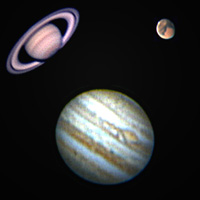| Planets | ||||||||||||||||||||||||||||||
 The
marvels of our own solar world are the nine planets orbiting the Sun. The
innermost planet, Mercury, is only half the size of our Moon and
completes an orbit every 88 days. There are extreme temperature
differences between day and night on Mercury, baking at 450 degrees C
during the day and freezing at -212 degrees C at night. The
marvels of our own solar world are the nine planets orbiting the Sun. The
innermost planet, Mercury, is only half the size of our Moon and
completes an orbit every 88 days. There are extreme temperature
differences between day and night on Mercury, baking at 450 degrees C
during the day and freezing at -212 degrees C at night.Venus is similar in size to Earth yet suffers from a runaway greenhouse effect due to a dense carbon dioxide atmosphere trapping heat from the Sun. As a result, it's hot on Venus (460 degrees C). The bright cloud cover makes Venus the brightest object in the sky as seen from Earth after the Sun and Moon. Our Earth is the third planet, the only place in our solar system known to harbour life. Its atmosphere and magnetic field shield the planet's biosphere from the harmful effects of space radiation. At half of the Earth's size, Mars is our nearest neighbour at a distance of just 35 million miles. It has a very thin atmosphere and gravity on Mars is roughly 1/3 of that on Earth. Beyond the four inner planets lie the gas giants. At a distance of half a billion miles from the Sun, Jupiter is 318 times more massive than Earth and features no less than 63 moons. Its huge cloud belts swirl around the visible surface of the atmosphere, generating Earth-sized storms including the Giant Red Spot with wind speeds of more than 400 mph. Stunning Saturn is the jewel of the solar system with 33 moons and spectacular rings, nearly 1 billion miles from the Sun. It is the lightest planet, with a density just one tenth of Earth's. Uranus also features a ring system and circles the Sun at a distance of 1.8 billion miles, taking 84 years to complete one orbit. Its rotational axis is tilted heavily, probably as a result of a catastrophic collision with another planet-sized body. The outermost planets, Neptune and Pluto, only capture a tiny amount of heat and light from the distant Sun. Neptune is 2.8 billion miles from our star, and Pluto has a highly elliptical orbit with a near point slightly nearer than Neptune and a far point of 4.5 billion miles from the Sun. It takes Pluto 248 years to complete one orbit, and it is the smallest planet in our solar system with a diameter of 1,430 miles.
|
||||||||||||||||||||||||||||||
|
||||||||||||||||||||||||||||||
















_DSC-V1_x80.jpg)





